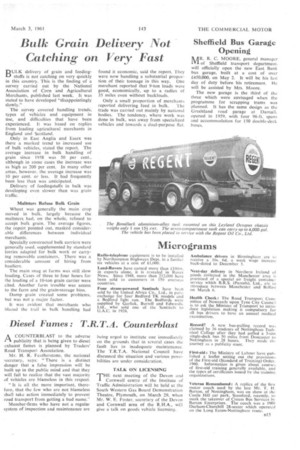Bulk Grain Delivery Not Catching on Very Fast
Page 43

If you've noticed an error in this article please click here to report it so we can fix it.
DULK delivery of grain and feeding
stuffs is not catching on very quickly in this country. This is the finding of a survey carried out by the National Association of Corn and Agricultural Merchants, published last week. It was stated to have developed "disappointingly slowly."
The survey covered handling trends, types of vehicles and equipment in use, and difficulties that have been experienced. It was based on replies from leading agricultural merchants in England and Scotland.
Only in East Anglia and Essex was there a marked trend to increased use of bulk vehicles, stated the report. The average increase in bulk handling of grain since 1958 was 50 per cent., although in some cases the increase was as high as 200 per cent. In many other areas, however, the average increase was 10 per cent. or less. It had frequently been less than was anticipated.
Delivery of feedingstuffs in bulk was developing even slower than was grain traffic.
Malisters Refuse Bulk Grain
Wheat was generally the main crop moved in bulk, largely because the maltsters, had, on the whole, refused to accept bulk grain. The average figures, the report pointed out, masked considerable differences between individual merchants.
Specially constructed bulk carriers were generally used, supplemented by standard lorries adapted for bulk work or carrying removable containers. There was a considerable amount of hiring from hauliers.
The main snag at farms was still slow loading. Cases of three to four hours fOr the loading of a 10-ton grain carrier were cited. Another farm trouble was access to the farm and the grain-storage bins.
Damp grain created some problems, but was not a major factor.
It was evident that merchants who blazed the trail in hulk handling had
found it economic, said the report. They were now handling a substantial proportion of their tonnage in this way. One merchant reported that 9-ton loads were good, economically, up to a radius of 35 miles even without backloads.
Only a small proportion of merchant, reported delivering feed in bulk. The trade was carried out mainly by national bodies. The tendency, where work was done in bulk, was away from specialized vehicles and towards a dual-purpose flat.




































































































































